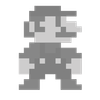Nintendo has always been a company that forges its own path. Yes, there are sometimes some deeply questionable things around some of the bends along that path (the bizarre yet oddly enticing Virtual Boy for instance), but that’s exactly why you shouldn’t be afraid to innovate.
You might have terrible ideas at times, and very public ones, but they’re your own, and that really counts for something.
More importantly, though, Nintendo’s first-party IPs are some of the most unique system-sellers around. Ten years ago, a series arrived that, on paper, might seem like one of the strangest they’ve ever created. Odd little octopus/squid creatures that spray each other with ink-guns? What are you talking about, Nintendo?
As it turned out, Splatoon is what they were talking about, and the gaming world would soon be listening intently.
Now, the original Splatoon had the misfortune of an exclusive launch on the troubled Wii U, which meant that its potential buyer base was more limited than it needed to be. I’m one of those fabled Wii U enjoyers, though, and I was thrilled to see a game that put the system on the map to any extent.
Back then, it was difficult to imagine Nintendo developing a third-person shooter, and naturally, this was the furthest thing from the storied Gears of War series. Chainsawing foes in half would probably be frowned upon a little by Nintendo’s audience, so a slight change in direction was needed.
What we have is a bright and extremely colorful shooter, with unique, very smooth movement mechanics, a musical vibe all its own (what a soundtrack), and game modes that subvert genre expectations.
This is the kind of thing that happens when Nintendo tries its hand at an established genre, and two sequels later, the Splatoon series has become one of its most popular outside-the-Mushroom-Kingdom properties.
The formula was quickly established. It’s a team-based game with the primary draw being Turf Wars, in which both sides have a limited time to cover the arena in their team’s color of ink.
A Splattin’ Good Time
This move, I’ve always felt, adds a fascinating tactical layer to the typical shooter concept of blast the other players. The opposing team’s ink will slow you down and damage you, while switching into squid form allows you to quickly swim through or hide in your own team’s.
You can make a dash for the other team’s position and try to take them down. You can slowly and steadily ‘paint’ the area your own team starts from and proceed outwards. You can lurk in your own paint waiting for foes to appear to convert it, then leap out and try to take them down.
Depending on the way the match is going, your approach might well switch between them all.
Turf Wars are dynamic matches that play out in just a short time, so it’s important to be able to react to what’s happening. The series would add and develop other modes as it went on, like the gripping co-operative Salmon Run and some other more conventional objective-capturing modes.
The crux of the multiplayer experience has always been the core Turf War for me, though, and it’s absolutely what I remember most fondly from my time with the series.
I like a competitive multiplayer title, but also one that doesn’t take itself too seriously. Another of Nintendo’s unique IPs, ARMS, embraced that spirit well, and the two titles share quite a lot in common despite the different genres.
With the varied loadouts they offer, there’s a lot more strategy to the games than meets the eye (adding the abilities you want to your Splatoon gear can be a painstaking process), and they also share fun multiplayer events in common. In ARMS Party Crashes (long-since stopped, sadly), just as in Splatoons’ Splatfests, players choose a side to fight for and battle other teams to advance their own cause.
I think both of these titles show off Nintendo at its best and most creative, and while ARMS is largely forgotten now, tragically, Splatoon 3 is set to hold a 2025 Splatoween event, 10 years after the original game landed.
Myself, I’m primarily a Roller user, and leap out of the murk to Splat a foe before clinching the game with a last-second coating of ink is still as wonderful a feeling as it ever was. It’s a series that gets bigger and better with every sequel, and I’m excited to see the new weapons, stages, and gear that arrive in the unconfirmed but seemingly-inevitable Splatoon 4.




